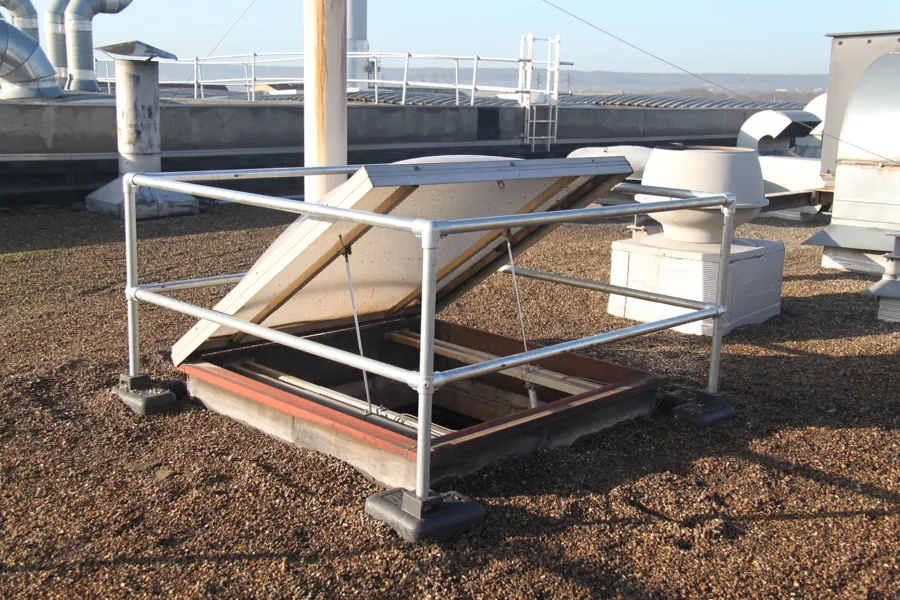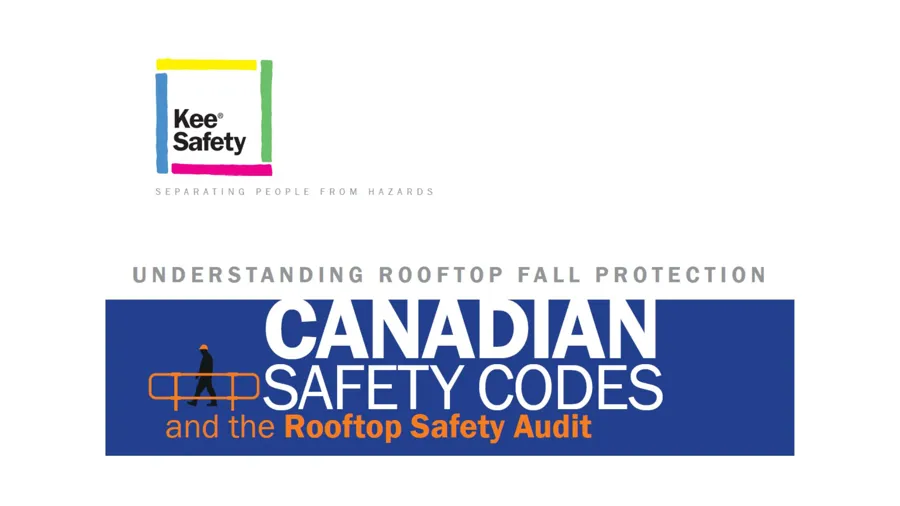
You are visiting the Canada Kee Safety website from United States. Would you like to go to the United States site?
Is there anyone who does not recognize the danger of working on a roof?
It is not news that falling from the edge of a roof—even a one-story building—can result in serious injury or death. What is often less noticed are several other hazards that maintenance, repair, and construction workers face when performing their jobs on flat and low-slope commercial, institutional, and industrial rooftops.
The first step in working safely on a roof is to identify the hazards. In addition to the roof edge, some risks include roof access, holes in the roof, traversing the roof’s surface, and obstacles on the roof. It is then incumbent to install effective and compliant safety systems and equipment and provide workers with certified training to enhance their awareness of safe procedures and the proper inspection and use of safety equipment.

A roof hatch provides building security and control for roof access. Although roof hatch manufacturers engineer their products for durability and ease of operation, a complete system should have roof hatch railings.
Railings set around the hatch help employees safely transition from an internal ladder through the roof hatch and onto the roof. When equipped with a self-closing safety gate, the roof hatch railings also provide fall protection for workers when the hatch is open.

As noted, the roof edge is a clear and present danger. Where possible and practical, roof perimeter railings are the preferred method for rooftop fall protection. Roof guardrails are defined as a “passive” system because it protects the maximum number of workers with minimum employee involvement or training.

Where perimeter guardrails are not present or practical, workers should be equipped with a Personal Fall Arrest System (PFAS), such as a horizontal lifeline system. Horizontal lifelines can be installed on structural roofs, membrane roofs, metal sheet roofs, overhead, or to the sides of structures. They are shock-absorbing, allow for freedom of movement, and can accommodate up to three workers.
Vertical and self-retracting lifelines with harnesses, lanyards, rope grabs, deceleration devices, and other components also provide vital fall protection or arrest. Horizontal and vertical lifelines are categorized as “active” fall protection because they personally and actively involve the worker.

A lifeline system—whether horizontal or vertical—requires an anchor or tie-off point.
Permanent roof anchors are upright posts attached to the underlying structure of flat or low-slope roofs, BUR or single-ply membrane systems, modified bitumen, green roofs, or metal roofs with underlying steel, wood, or concrete structures.
Mobile roof anchors provide flexibility for flat roofs and roofs with a pitch of up to 5°. They have rubber-coated base weights with suction cups and a central pedestal to attach to a horizontal or vertical lifeline. (Note: mobile roof anchors can be used on a roof with a pitch of up to 15° when the anchor and person attached to the lifeline are on opposite sides of the peak of the roof.)

Working on a roof often includes accessing many areas of the roof. An anti-slip roof walkway system is recommended for protecting the worker traversing over water, snow, and ice—obvious trip hazards—through curved areas, up and down inclines, and other features on a roof. Walkways present a clear path of where workers should be operating. A roof walkway with guardrails provides added roof fall protection.

Among the least considered rooftop hazards are obstacles such as piping, ductwork, and cables. Whether these impediments are small or large, it may be tempting for the worker to hop over or scale them. The safer way is to install modular “Crossover” steps that feature anti-slip treads, non-penetrating bases, and corrosion-resistant frames and railings to enable workers to cross over these hazards.
Skylights and roof domes may seem secure, but they are considered holes in the roof and not necessarily able to support the weight of a worker that steps or falls onto a skylight or dome. A roof dome railing set or a skylight screen will provide fall protection.

A rooftop can fully comply with safety regulations; however, if employees are not adequately trained, they are still at risk. Certified training for working at heights and using a harness and lanyard combines the theoretical with the practical. Training details legal requirements and standards, types and selection of necessary equipment, inspection and use of the equipment, emergency procedures, and other relevant factors.

What experts look for when performing a rooftop safety audit and how to improve worker safety with solutions that exceed OH&S compliance.